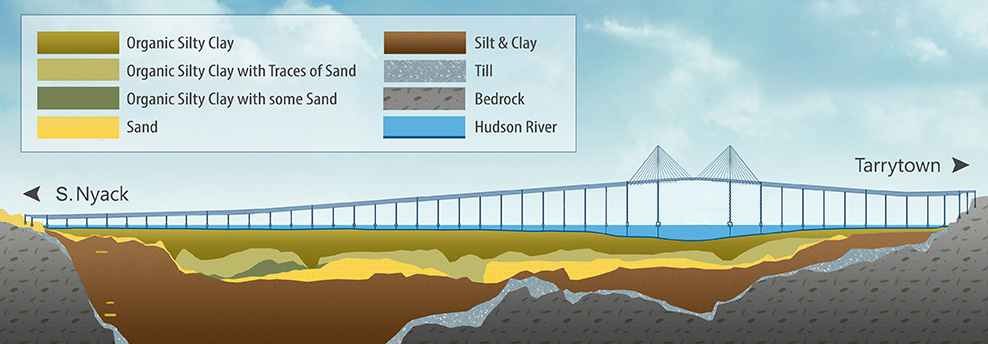
The tops of the New NY Bridge’s steel piles reveal only a fraction of their full length, some of which extend hundreds of feet into the riverbed.
The Hudson Valley is a unique geological formation, created by receding glaciers tens of thousands of years ago. As the colossal sheets of ice melted and formed the Great Lakes, the melt-water rushed down the Palisades and filled the Hudson Valley with enough sediment to bury the Statue of Liberty. This torrential force of nature created the striking Hudson Valley landscape and more recently, a number of geotechnical hurdles for the New NY Bridge project.
The design of the new bridge’s foundation has been informed by a series of geotechnical investigations. These studies included more than six dozen soil borings of the riverbed on the bridge site, some up to 440 feet down into the earth.

This illustration shows the layers of clay, silt and sand that cover the bedrock beneath the Hudson River. This information guided the design of the new bridge’s foundations.
The investigations revealed varying layers of clay, silt, sand and glacial till covering the bedrock beneath the Hudson River. Notably, an extraordinarily deep “valley” of clay was identified beneath the western half of the river (pictured above).
Based on the geotechnical findings, designers selected a concrete-filled steel tube, or “pile” foundation system to support the New NY Bridge. While most of the bridge’s piles rest on solid bedrock, the depth of the clay valley requires a different approach. Here, bridge engineers proposed using longer piles, which would “cling” to the layers of clay around their sides through friction. The greater surface area of these piles will create plenty of tension, enough to support the load of the bridge for the next 100 years or more.
In order to categorically ensure these piles would work as designed, the New NY Bridge team conducted numerous load tests on the project site during the fall of 2013.

Massive weights were used to analyze test piles. Here, an entire barge filled with water is used as part of the load-bearing test of a single pile.
Sophisticated monitoring equipment was employed to analyze the piles as weight was added. Different weights were used to test different piles – in some instances up to 7 million pounds, equivalent to the weight of 2,000 cars. These tests confirmed the carrying capacity of the pile system.
Following the successful load tests, permanent pile installation began in fall 2013. As we approach fall 2014, permanent pile installation is on schedule with just over 50 percent of the piles installed. When the project is complete in 2018, the sturdy foundation design will ensure safe passage for generations of motorists and mass transit riders alike over the next century.
